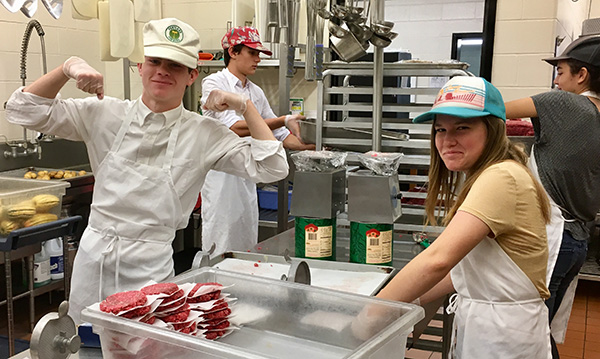On Wednesday, October 24, Harwood Union Middle/High School served a meal cooked on site, from scratch, with most ingredients sourced within a 25-mile radius of the school. Students and their mentors worked ahead of time to prepare the food that would be served to the rest of the student body. Students prepped burgers, diced potatoes, mixed greens and put together a spectacular dessert that went on lunch trays to celebrate National Farm to School Month.
October is National Farm to School Month and Harwood celebrated the harvest with a localvore luncheon featuring fresh ground Neill Farm beef (Waitsfield), black beans sourced from Vermont Bean Crafters (Waitsfield), delicata squash and kale from Ananda Gardens (Montpelier), potatoes from Hartshorn Organic Farm (Waitsfield), and Vermont pure maple syrup.
“It’s only the beginning,” said Tara Cariano, a counselor at Harwood who is working on a fellowship alongside Ryan Morra, STEM Teacher for the Harwood Community Learning Center.
The pair helps guide the student work program that connects the student body to the community, that all go toward the kitchen.
Cariano said she felt that food is a way to connect; the harvest meal is a connection by bringing the outside community in.
Two of the students involved with the project, Charlotte Cook and Jasper Koliba, spoke about their visit to a Montpelier school where they saw an example of a harvest meal on a bigger scale.
“We got to see their local meal; they had activities and workshops throughout the day. They grew a lot of their food at the school and we got to visit their greenhouse and their gardens and it was really cool,” said Cook.
The students meet monthly and, after the success of the harvest meal at Harwood, hope to produce taste tests of seasonal food varieties for the student body to try. The student-run group looks to the Montpelier school as an example. The Harwood group has 11 students and is growing.
Koliba hopes that the group can put on more meals and activities to gain student interest and so students and faculty can incorporate the local farm-to-table mentality.
Morra and Cariano spoke about the benefits of the student-run group, adding that it creates a healthier school community and allows the students to practice their social skills by working with farmers to create a relationship that could go beyond high school.
“Every month there is a harvest of the month which includes a food that is in season, and so we are going to take those foods and make a taste test. The kitchen will try to incorporate the foods into their school lunches, depending on the student’s feedback of the initial taste test,” said Koliba.
The students talked about the kitchen’s openness to try new food. In a rough guess-estimate from Morra and food service director Paul Morris, 20 percent of Harwood’s lunches come from local communities. Morris added that their goal would be to have at least a third of the food come locally.







